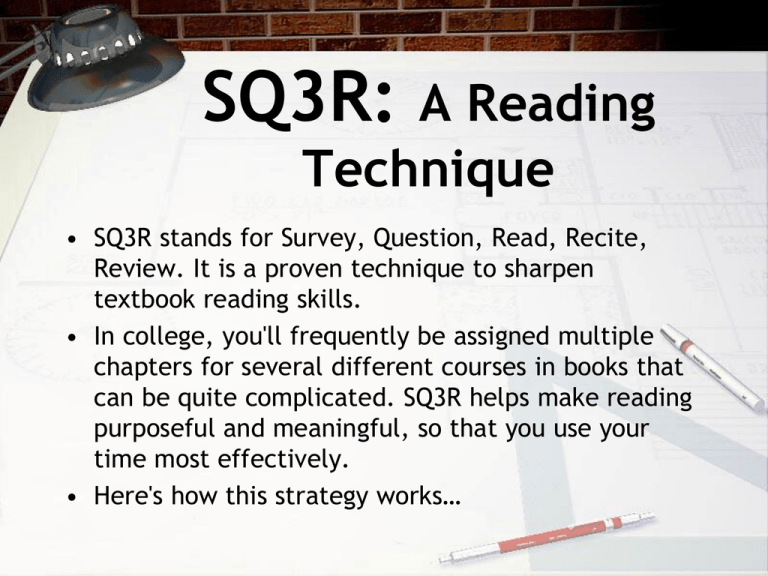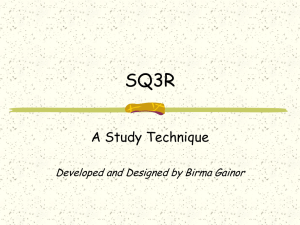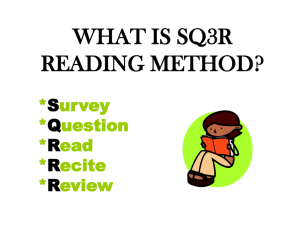SQ3R: A Reading Technique - Oakton Community College
advertisement

SQ3R: A Reading Technique • SQ3R stands for Survey, Question, Read, Recite, Review. It is a proven technique to sharpen textbook reading skills. • In college, you'll frequently be assigned multiple chapters for several different courses in books that can be quite complicated. SQ3R helps make reading purposeful and meaningful, so that you use your time most effectively. • Here's how this strategy works… SQ3R: Survey • Get an idea of what the chapter is about by reviewing the highlights: • Read the title, headings, and subheadings. • Take note of words that are italicized or bold. • Look at charts, graphs, pictures, maps, and other visual material. • Read captions. • Read the very beginning and end of the chapter. SQ3R: Question • As you survey the text, ask a question for each section. Ask what, why, how, when, who and where questions as they relate to the content. Here's how you can create questions: • Turn the title, headings, or subheadings into questions. • Rewrite the questions at the end of the chapter or after each subheading in your own words. • Write down your questions. Questions help you pay attention, understand the text better, and recall the information more easily later on. SQ3R: Read • Read one section of a chapter at a time, actively looking for an answer to your question for that section. • Pay attention to bold and italicized text that authors use to make important points. • Be sure to review everything in the section, including tables, graphs, and illustrations, as these features can communicate an idea more powerfully than written text. SQ3R: Recite • At the end of each section, look up from the text and in your own words recite an answer to your question for that section. Then write down your answer. Be sure to provide examples that support it. • Now repeat the Question, Read, and Recite steps for each section of the chapter or assigned reading. First ask a question for the next section. Then read to find the answer. Finally, recite the answer in your own words and jot it down. The written questions and answers will help you study in the future. SQ3R: Review • After completing each chapter or reading assignment, review your notes. Identify the main points of the reading by looking for the most important idea in each section. Recite, or write, a brief summary of the chapter or assignment. • Review your study notes every week to help you remember the information. That’s the SQ3R Reading Technique! Reading Primary and Secondary Sources • Primary Source material written in some original form; more difficult reading level. – Autobiographies – Speeches – Research Reports – Government Documents – Scholarly Articles • Secondary Source summarizes or interprets primary sources – Magazine Articles – Textbooks Developing Your Vocabulary • Jot down unfamiliar terms and find the meaning using a dictionary. – Consider the context around new and challenging words. – Analyze terms to discover the most meaningful part of the word. – Take the opportunity to use new terms in your writing and speaking. • Use Vocabulary software on the computers in the Learning Center or Computer Labs. • Read scholarly journals in areas of your interest and read the newspaper more often. Ask the librarian how to find these. A Reader’s Glossary Cause-effect How one thing causes another to happen Compare-contrast How things are similar and how they are different Draw a conclusion Context clue Implied To make up your mind about an idea Inference Main idea Objectivity To guess or speculate to draw a conclusion Prior knowledge What you already know Supporting details Specific items that elaborate on the main idea Getting the meaning of a word from the words around it Suggested without being directly stated The primary subject of a passage or paragraph Not influenced by personal feelings or prejudice Reviewing • Review to remember the main points of the material. • Test yourself on your comprehension. • Some ways to review: – – – – – notes study questions flash cards visual maps outlines • Make reviewing every week a study goal. Tips for Improving Reading Ability • Find a quiet study location. • Read in 25-minute blocks with 5 minute breaks in between. • Take notes, recite key ideas or jot down questions in the margins. • Focus on key issues in the text. • Experiment with your reading rate. Can you speed up? Highlighting Text • Highlight: – Topic sentences, Key words, Conclusions • But, watch out! – Highlighting too much can cause you to re-read everything because you don’t know what’s important. – Highlighting doesn’t show you why you highlighted something – You need to have the entire text with you to review. Important Points About College Reading • You are expected to read the material and understand it on your own. • Successful students complete assigned readings before class to help them understand the lecture. • Connections and overlaps between lecture and reading reinforce learning. • Instructors do NOT always cover the reading material in lecture. One Minute Paper What reading techniques can you use to enhance your studying success? What resources can you use at Oakton for Reading help? What questions do you still have?








